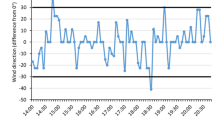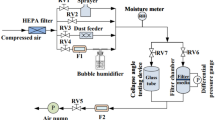Abstract
THE rate of tatter of standardized textile flags has been used as a cheap and convenient index of exposure to wind1–3, but no attempt has been made to determine whether, or to what extent, water in the flag affects the rate of tatter. This effect has been measured to determine whether loss in dry matter may be substituted for loss in area as a measure of tatter, and whether it is acceptable to remove the protective fray from a used flag in order to re-expose it on its original site for further periods.
This is a preview of subscription content, access via your institution
Access options
Subscribe to this journal
Receive 51 print issues and online access
$199.00 per year
only $3.90 per issue
Buy this article
- Purchase on Springer Link
- Instant access to full article PDF
Prices may be subject to local taxes which are calculated during checkout
Similar content being viewed by others
References
Cole, J. A., and Green, M. J., I.A.S.H. Committee for Evaporation, Publ. 62, 190 (1963).
Lines, R., and Howell, R. S., Forest Record, No. 51 (H.M. Stationery Office, 1963).
Thomas, D., Met. Mag., 99, 67 (1959).
Author information
Authors and Affiliations
Rights and permissions
About this article
Cite this article
RUTTER, N. Tattering of Flags under Controlled Conditions. Nature 205, 168–169 (1965). https://doi.org/10.1038/205168a0
Published:
Issue Date:
DOI: https://doi.org/10.1038/205168a0
This article is cited by
-
Species richness, abundance, rarity and environmental gradients in coastal barren vegetation
Biodiversity and Conservation (2009)
Comments
By submitting a comment you agree to abide by our Terms and Community Guidelines. If you find something abusive or that does not comply with our terms or guidelines please flag it as inappropriate.



